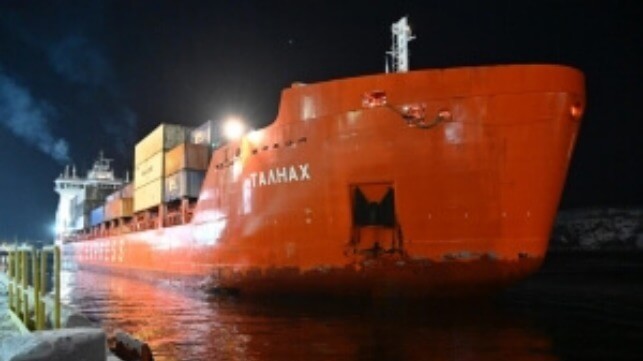Russia Claims New Record for Cargo on the Northern Sea Route

As of the last week of 2023, Russian officials were claiming to have reached a record level of cargo moving along the Northern Sea Route while expecting to continue to increase the total to the end of the year. The reports are saying that volumes recovered from the 2022 downturn which was due to “geopolitical factors” and laying the groundwork for the continued expansion of the route.
On the night of December 20-21, the Talnakh (17,940 dwt), a Russian cargo ship, established the record for the year. The vessel which operates for Norilsk Nickel between the inland port of Dudinka on the Kara Sea and Murmansk on the Barents arrived in Murmansk carrying 17,000 tons of cargo.
The trip was in part made possible by two of FSUE Atomflot’s nuclear icebreakers which operate under long-term contract to Norilsk Nickel. The vessels were required to lay and maintain a channel from Dudinka along the Yenisei River to the Kara Sea. It was one of 730 vessel supports provided by the icebreakers in 2023, which is up from 653 in 2022.
With the arrival of the cargo, FSUE Atomflot reports they surpassed 35 million tons of cargo transported on the route in 2023. By comparison in 2022, 34.117 million tons of cargo were moved on the route. While it is a 2.5 percent increase year-over-year, they report that the target is to move 100,000 tons a day on the route. By the end of 2023, they expect the increase could reach 2.127 million tons over last year.
The figure is also significant because it also passed the previous record of 34.9 million tons transported along the route in 2021. They contend that freight traffic in the waters of the Northern Sea Route is showing stable growth.
Russian officials highlight that it is part of the long-term plan to redirect cargo from the Suez Canal and grow the Northern Sea Route, which is over 3,452 miles long connecting the Barents Sea and the Bering Strait. They highlight that the route has grown from 7 million tons of cargo 36 years ago, in 1987, under the old Soviet Union.
President Vladimir Putin has named the growth of the Northern Sea Route as one of Russia’s top priorities. In addition to the approval to begin year-round transit on the route, they point to plans to increase the infrastructure capacity to accommodate 80 million tons by 2024 and 110 million tons by 2030. Russia’s goal is to reach 220 million tons of cargo transported annually on the Northern Sea Route.
No comments:
Post a Comment